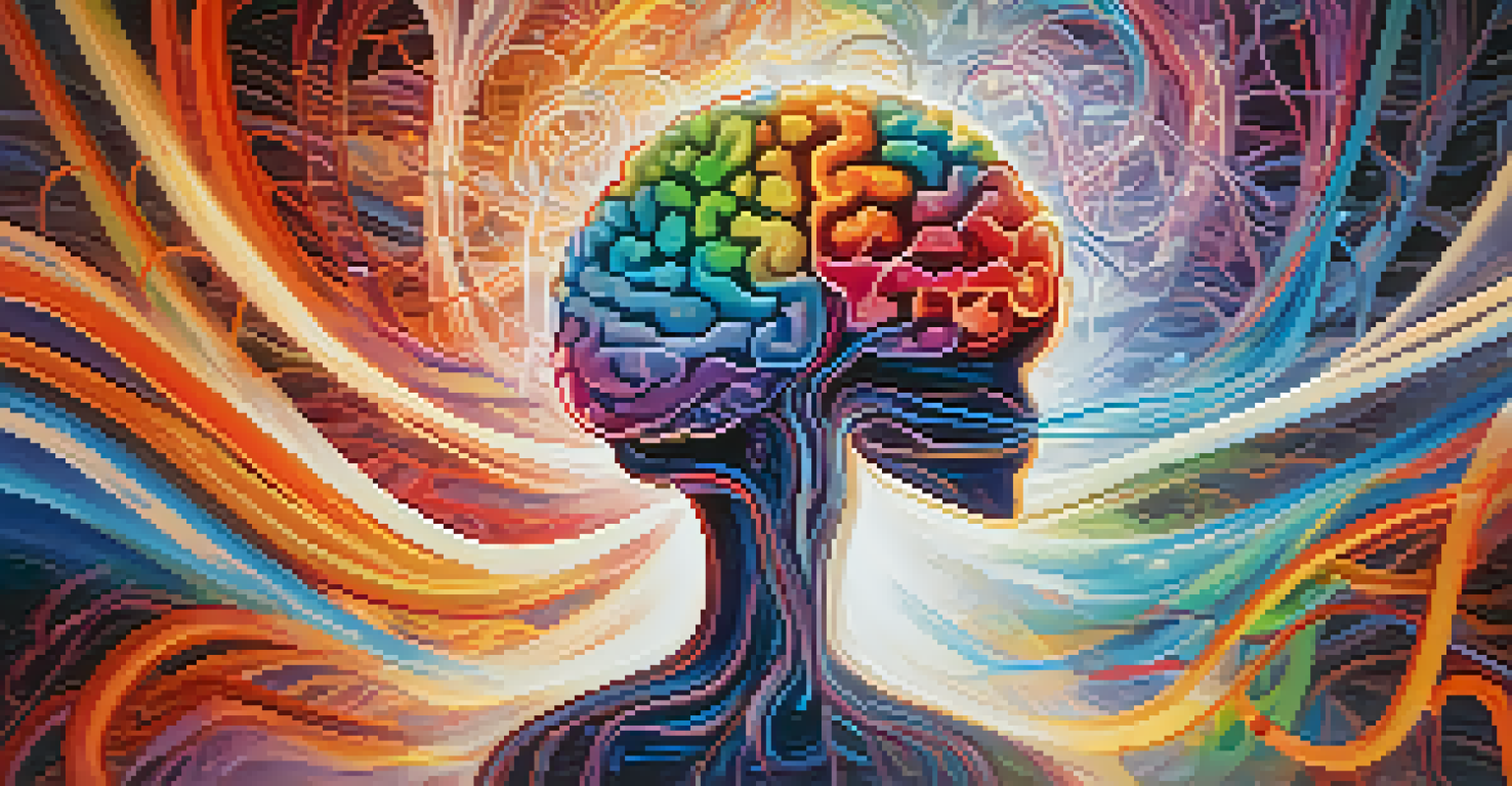Enhancing CBT Outcomes with Hallucinogenic Substances

Understanding Cognitive Behavioral Therapy (CBT)
Cognitive Behavioral Therapy, or CBT, is a popular form of psychotherapy that focuses on changing negative thought patterns. It helps individuals identify and challenge irrational beliefs while promoting healthier behaviors. By addressing these cognitive distortions, CBT can lead to improved mental health outcomes.
The mind is everything. What you think you become.
Often seen as a structured approach, CBT is used to treat various conditions, including anxiety and depression. Patients typically engage in weekly sessions where they learn practical skills and coping strategies. This hands-on method can empower individuals to take charge of their mental well-being.
However, despite its effectiveness, some patients may find traditional CBT challenging or insufficient. This is where exploring new avenues, like the integration of hallucinogenic substances, comes into play. By expanding treatment options, we can potentially enhance the benefits of CBT.
The Role of Hallucinogenic Substances in Therapy
Hallucinogenic substances, such as psilocybin and LSD, have been gaining attention for their therapeutic potential. These substances can alter perception and induce profound experiences that some individuals find transformative. In recent years, research has begun to explore how these experiences can complement traditional therapies like CBT.

Studies suggest that hallucinogens can help break down mental barriers and lead to new insights. For instance, patients often report a heightened sense of connection to themselves and the world around them after using these substances. This altered state may open pathways for deeper emotional processing, which can be beneficial during therapy.
CBT Transforms Negative Thinking
Cognitive Behavioral Therapy (CBT) effectively helps individuals identify and change negative thought patterns to improve mental health.
Moreover, the integration of hallucinogens in a controlled therapeutic setting can foster a sense of safety and support. By combining the insights gained from these experiences with CBT techniques, therapists can guide patients towards meaningful change. This innovative approach is exciting and represents a shift in how we view mental health treatment.
Current Research on Hallucinogens and CBT
Research into the effects of hallucinogenic substances on mental health is expanding, with several studies showing promising results. For example, a clinical trial involving psilocybin demonstrated significant reductions in anxiety and depression among participants. These findings suggest that hallucinogens can enhance the therapeutic process when paired with CBT.
The greatest discovery of my generation is that a human being can alter his life by altering his attitudes.
In addition to alleviating symptoms, research indicates that hallucinogens may facilitate a more profound emotional experience. This can lead to breakthroughs in therapy, allowing individuals to confront and process difficult emotions. The combination of these substances with CBT techniques can create a potent therapeutic alliance.
As the research continues to evolve, it's essential to approach these findings with caution. While the potential is exciting, further studies are needed to understand the long-term effects and best practices for integrating hallucinogens into therapeutic settings. It’s a promising frontier, but one that requires thorough exploration.
Mechanisms Behind Hallucinogenic Effects
The mechanisms by which hallucinogenic substances exert their effects are complex and still being studied. These substances primarily act on serotonin receptors in the brain, which can lead to altered perceptions and feelings. This interaction may facilitate a shift in perspective, making it easier for individuals to confront their thoughts and emotions during therapy.
For instance, when someone experiences a hallucinogenic trip, they may encounter feelings of awe or connectedness that challenge their usual thought patterns. This shift can help individuals see their problems in a new light, making it easier to engage with CBT techniques. This blending of experiences can lead to deeper self-reflection and insight.
Hallucinogens Enhance Therapy
Research suggests that integrating hallucinogenic substances like psilocybin with CBT can facilitate deeper emotional processing and therapeutic breakthroughs.
Additionally, hallucinogens may promote neuroplasticity, the brain's ability to reorganize itself. This means that new neural pathways can be formed, potentially allowing for more effective learning and adaptation. When combined with the structured approach of CBT, this could pave the way for more resilient mental health.
Safety and Ethical Considerations
While the potential benefits of combining hallucinogens with CBT are intriguing, safety and ethical considerations are paramount. Hallucinogens can produce intense experiences, which may not be suitable for everyone. It’s crucial to ensure that patients are adequately screened and supported throughout the process.
Therapists must also be trained in managing the unique challenges that can arise during a hallucinogenic experience. This includes preparing patients for what to expect and establishing a safe environment for exploration. Safety protocols should be in place to address any adverse reactions or psychological distress that may occur.
Moreover, as we navigate this emerging field, ethical guidelines must be developed to protect patients. This includes considerations around consent, accessibility, and the potential for misuse. By prioritizing safety and ethics, we can responsibly explore the integration of hallucinogens in therapeutic settings.
Personal Stories: Transformative Experiences
Many individuals have shared personal accounts of how hallucinogenic experiences have transformed their lives. One common theme is the feeling of liberation from past traumas or entrenched negative thought patterns. These stories highlight the potential for profound change when combined with therapeutic approaches like CBT.
For instance, a participant in a psilocybin study recounted how their experience allowed them to confront deep-seated fears, enabling them to engage more fully in CBT sessions. This newfound courage can lead to more effective therapy, as individuals are better equipped to tackle their challenges. Personal stories like these underscore the human element behind the research.
Caution in New Treatment Approaches
While combining hallucinogens with CBT shows promise, it's crucial to prioritize safety and ethical considerations in therapeutic settings.
These narratives also serve as a reminder of the importance of integrating the personal with the clinical. Each person's journey is unique, and by sharing these experiences, we can foster a greater understanding of how hallucinogens might facilitate healing. It’s a testament to the power of the human spirit and the potential for transformative growth.
Looking Ahead: Future of CBT and Hallucinogens
As research continues to unfold, the future of integrating hallucinogens with CBT looks promising. There is a growing interest in developing protocols and frameworks for this innovative approach. By combining the structure of CBT with the potential insights gained from hallucinogens, we may be able to enhance therapeutic outcomes significantly.
Moreover, as societal attitudes towards hallucinogens shift, there may be increased acceptance of their use in therapeutic contexts. This could lead to more funding for research and clinical trials, ultimately benefiting those in need of effective mental health treatments. The collaboration between researchers, therapists, and patients will be crucial in shaping this future.

Ultimately, the goal is to create a more comprehensive and effective mental health care system. By keeping an open mind and continuing to explore new possibilities, we can pave the way for innovative treatments that truly address the complexities of the human experience. The journey is just beginning, and the potential for positive change is immense.